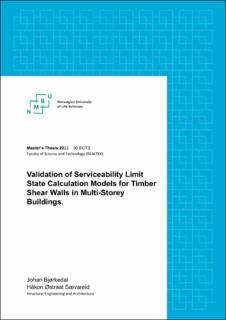| dc.contributor.advisor | Tomasi, Roberto | |
| dc.contributor.advisor | Boggian, Francesco | |
| dc.contributor.author | Bjørkedal, Johan | |
| dc.contributor.author | Sævareid, Håkon Østraat | |
| dc.date.accessioned | 2022-11-18T14:05:50Z | |
| dc.date.available | 2022-11-18T14:05:50Z | |
| dc.date.issued | 2022 | |
| dc.identifier.uri | https://hdl.handle.net/11250/3032920 | |
| dc.description.abstract | This thesis presents a parametric analysis of LTF and CLT, comparing numerical and analytical calculation models and researching the significance of the different contributions presented in a draft for the next Eurocode 5. On top of this, the thesis explores the validity of a numerical modal analysis of the InnoRenew CoE new headquarters in comparison with an experimental campaign executed on the building. Dynamic identification and finite element model updating is performed.
The parametric analysis of single shear walls analysis utilizes Open Application Programming Interface in Python to manipulate the Finite Element Method software SAP2000 to perform a series of analyses. The modelling is executed in a manner that allows extraction of results for single contributions in the numerical model and compare the results with the analytical equations for the same contributions presented in the draft for the next Eurocode 5.
The Finite Element model updating is based on an experimental campaign and a SAP2000 model of InnoRenew CoE new headquarters. The Finite Element model is updated using a differential evolution where the masses in different parts of the building are modified to optimize the numerical calculations.
Overall, the parametric analysis of single shear walls generated results in the numerical and analytical calculations that were quite similar. The contributions that presented results where the numerical and analytical models deviated, the deviation can be explained.
The Finite Element Model updating provided a significant improvement to the Total Convergence Criterium. However, due to excessive differences between initial dynamic identification and the experimental values, improvements were not sufficient. Therefore, the Total Convergence Criterium cannot be said to validate the model sufficiently. | en_US |
| dc.language.iso | eng | en_US |
| dc.publisher | Norwegian University of Life Sciences, Ås | en_US |
| dc.rights | Attribution-NonCommercial-NoDerivatives 4.0 Internasjonal | * |
| dc.rights.uri | http://creativecommons.org/licenses/by-nc-nd/4.0/deed.no | * |
| dc.title | Validation of serviceability limit state calculation models for timber shear walls in multi-storey buildings | en_US |
| dc.type | Master thesis | en_US |
| dc.description.localcode | M-BA | en_US |

